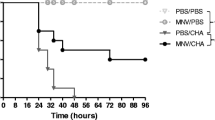Abstract
The aim of the present investigation was to evaluate the effect of rabbit anti-rat macrophage serum (AMS) on the oedema and cell migration induced by a preparation of M. tuberculosis. Inflammation induced by M. tuberculosis is known to recruit macrophages, and anti-macrophage serum was found to affect macrophages in vitro as well in vivo, and is becoming a valuable tool to study their various functions1–4.
Access this chapter
Tax calculation will be finalised at checkout
Purchases are for personal use only
Preview
Unable to display preview. Download preview PDF.
Similar content being viewed by others
References
Unanue, E. R. (1968). Properties and some uses of antimacrophage antibodies. Nature (London), 218, 36
Hirsh, M. S., Gary, G. W. Jr. and Murphy, F. A. (1969). In vitro and in vivo properties of antimacrophage sera. J. Immunol., 102, 656
Argyris, B. F. and Plotikin, D. H. (1969). Effect of antimacrophage serum on antibody production and phagocytosis in mice. J. Immunol., 103, 372
Gallily, R. (1971). In vitro and m vivo studies of the properties and effects of an ti-macrophage sera (AMS). Clin. Exp. Immunol., 9, 381
Coons, A. H. and Kaplan, M. H. (1950), Localization of antigen in tissues cells. II. Improvements in a method for the detection of antigen by means of a fluorescent antibody. J. Exp. Med., 91, 1
Ribeiro des Santos, R. S. and Hudson, L. (1980). Trypanosoma cruzi: Binding of parasite antigens to mammalian cell membranes. Parasite Immunol., 2, 1
Bøyum, A. (1976). Isolation of lymphocytes, granulocytes and macrophages. Scand. J. Immunol., 5, (Suppl. 5),
Stuart, A. E., Habeshaw, J. A. and Davidson, E. A. (1978). Phagocytes in vitro. In Weir, D.M. (ed.) Handbook of Experimental Immunology, Vol. 2. Cellular Immunology, pp. 1–30. (Oxford: Blackwell Scientific)
Ouchterlony, Ö (1958). Diffusion in gel methods for immunological analysis. Prog. Allergy, 5, 1
Wadsworth, A., Maltaner, E. and Maltaner, F. (1931). The quantitative determination of the fixation of complement by the imune serum antigen. J. Immol., 21, 241
Ferreira, S. H. (1979). A new method for measuring variations of rat paw. J. Pharm. Pharmacol., 31, 649
Chalkley, H. W-. (1943). Method for the quantitative morphologic analysis of tissues. J. Natl. Cancer Inst., 4, 47
Feldman, J. D., Tubergen, D. G., Pollock, E. M. and Unanue, E. R. (1972). Distribution of a macrophage specific antigen. Cell. Immunol., 5, 325
Jennings, J. F. and Hughes, L. A. (1969). Inhibition of phagocytosis by anti-macrophage antibodies. Nature (London), 221, 79
Jasin, H.E., Lennard, D. and Ziff, M. (1971). Studies on antimacrophage globulin. Clin. Exp. Immunol., 8, 801
Despont, J.P. and Cruchaud, A. (1969). In vivo and in vitro effects of anti-macrophage serum. Nature (London), 223, 838
Kazmierowski, J. A., Gallin, J. I. and Reynolds, H. Y. (1977). Mechanism for the inflammatory responses in primate lungs. Demonstration and partial characterization of an alveolar macrophage-derived chemotactic factor with preferential activity for polymorphonuclear. J. Clin. Invest., 59, 273
Ferreira, S. H. (1980). Are macrophages the body’s alarm cells? Agents Actions, 10, 229
Author information
Authors and Affiliations
Editor information
Editors and Affiliations
Rights and permissions
Copyright information
© 1980 MTP Press Limited
About this chapter
Cite this chapter
Ferreira, S.H., De Souza, G.E.P., Ribeiro Dos Santos, R. (1980). In vivo inhibition of pmn migration by antimacrophage serum. In: Willoughby, D.A., Giroud, J.P. (eds) Inflammation: Mechanisms and Treatment. Inflammation: Mechanisms and Treatment, vol 4. Springer, Dordrecht. https://doi.org/10.1007/978-94-010-9423-8_114
Download citation
DOI: https://doi.org/10.1007/978-94-010-9423-8_114
Publisher Name: Springer, Dordrecht
Print ISBN: 978-94-010-9425-2
Online ISBN: 978-94-010-9423-8
eBook Packages: Springer Book Archive




